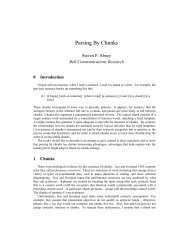50 CHAPTER 2. NOUN PHRASE AND SENTENCEthe licens<strong>in</strong>g of Det without <strong>in</strong>vent<strong>in</strong>g a new k<strong>in</strong>d of relation the licens<strong>in</strong>gof Det generalizes with that of In and Comp.<strong>The</strong>re are further X-bar theoretic considerations that make the Detas-headanalysis attractive. First, D is no longer defective with respectto X-theory, but projects a phrasal node, and takes a complement, likeother categories. This is <strong>in</strong> keep<strong>in</strong>g with the analysis of I and C which hasemerged <strong>in</strong> recent years (see Chomsky 1981, Stowell 1981, Chomsky 1986a),<strong>in</strong> which IandCaretaken to participate fully <strong>in</strong> the X system. In fact, theDet-as-head analysis is almost forced if we wish to suppose generally that\non-lexical" categories are not defective with respect to X-bar theory.Another X-bar theoretic advantage of the Det-as-head analysis is thatdeterm<strong>in</strong>er and possessor no longer appear <strong>in</strong> the same position. <strong>The</strong>reis a tendency <strong>in</strong> current views of X-bar theory toward the position thatthere are X 0 positions, on the one hand, and X max positions, on the other,and the two are completely disjo<strong>in</strong>t. In the formulation of the X-schemagiven <strong>in</strong> Stowell 1981, the Spec position (like complement positions) canonly be lled with maximal projections, not X 0 's. An X 0 cannot ll anX max -position, and vice versa. This separation of X 0 and X max positionsis preserved and strengthened <strong>in</strong> Chomsky's recent work: an X max cansubstitute only <strong>in</strong>to an X max position, and an X max can adjo<strong>in</strong> only toan X max ,mutatis mutandis for X 0 . <strong>The</strong> Det-as-head analysis allows us toadopt this strong version of the Xschema, without confront<strong>in</strong>g us with theembarass<strong>in</strong>g question of why DetPnever conta<strong>in</strong>s any material except Det.With regard to complements and speciers, we nowhave avery symmetricsystem. Only functional categories (i.e., C, I, D) freely have (overt)subjects: 18 *[ IP (John) [ VP was Bill seen]], *[ DP (John's) [ NP Bill ('s)picture]]|if we assume that only functional categories can host AGR, thisfact is immediately accounted for. All and only subject positions are land<strong>in</strong>gsites for movement, where substitution is <strong>in</strong>volved: [ CP who [ IP Bill sawt]], [ IP Bill [ VP was seen t]], [ DP the city's [ NP destruction t]].Another factor which makes a parallel syntactic treatment of Det andIn attractive is their semantic similiarity. <strong>The</strong> function of the determ<strong>in</strong>eris to specify the reference of a noun phrase. <strong>The</strong> noun provides a predicate,and the determ<strong>in</strong>er picks out a particular member of that predicate's extension.<strong>The</strong> same function is performed <strong>in</strong> the verbal system by tense, orInection. <strong>The</strong> VP provides a predicate, that is, a class of events, and tenselocates a particular event <strong>in</strong> time. In Higg<strong>in</strong>botham's terms, In b<strong>in</strong>ds theVP's event place, <strong>in</strong> the same way that the Determ<strong>in</strong>er b<strong>in</strong>ds the open place<strong>in</strong> NP.18 <strong>The</strong> qualication \freely" is meant to exclude cases where ECM <strong>in</strong>to, say, SpecofAPor Spec of PP (under Stowell's (1981, 1982) account of small clauses) perm<strong>its</strong> subjectsto (exceptionally) appear <strong>in</strong> these categories.
3. THE DP-ANALYSIS 51Though the idea that the Determ<strong>in</strong>er is the head of the noun phraseseems rather odd at rst, the conceptual considerations I havejustsketchedmake it seem a very natural, even necessary development of current viewsof phrase structure. I will discuss the Det-as-head analysis <strong>in</strong> more detail<strong>in</strong> Chapter Four. I have <strong>in</strong>troduced it here because I will occasionally makereference to it <strong>in</strong> the rema<strong>in</strong>der of this chapter, and <strong>in</strong> the next.As a bibliographic note, I would also like topo<strong>in</strong>t out that the Detas-headanalysis, and the analysis <strong>in</strong> which there is an Inectional (i.e.,functional) head of the noun phrase, are also not so odd that others havenot thought of it before me. When I rst began explor<strong>in</strong>g the possibility,I thought it quite novel, but I have s<strong>in</strong>ce discovered comparable proposals<strong>in</strong> Brame 1981, 1982, Hale 1980, Hellan 1986, Horrocks & Stavrou 1985,Hudson 1984, Kornlt 1984, Kuroda 1986, Reuland 1985, Szabolcsi 1981,1984. For the most part, these authors appear to be unaware of each other'swork.<strong>The</strong> determ<strong>in</strong>er as head of the noun phrase is also, of course, a very wellestablishedtenet <strong>in</strong> the Montagovian semantic tradition (Montague 1974),and receives particular attention <strong>in</strong> the Generalized Quantier proposal ofBarwise & Cooper 1981, cf. Higg<strong>in</strong>botham & May 1980.3.5 <strong>The</strong> Position of 'sIn this section, I would like to consider how Case is assigned to the possessorunder the DP-analysis. It is generally assumed that the 's is <strong>in</strong>volved <strong>in</strong>Case-assignment to the possessor. But what precisely is the position of 's,and what is <strong>its</strong> relation to the possessor?3.5.aMorphological Case AxOne possibility that can be immediately elim<strong>in</strong>ated is that 's is a morphologicalcase-mark<strong>in</strong>g. As is well-known, 's cliticizes to the entire subjectnoun phrase it does not appear simply as an ax on the head: 19,20(61) a. [a cous<strong>in</strong> of m<strong>in</strong>e]'s houseb. [the man <strong>in</strong> the store]'s sudden disappearance19 If words like m<strong>in</strong>e, your, are suppletive from I's (or me's), you's, then cliticizationof 's feeds morphological processes. This is not problematic.20 <strong>The</strong> text examples are not perfectly well-formed. Later, <strong>in</strong> a dierent context, I markthem as marg<strong>in</strong>al. I th<strong>in</strong>k they are suciently good, though, to illustrate the claim that's is not simply a case ax which attaches to the head of the noun phrase.



